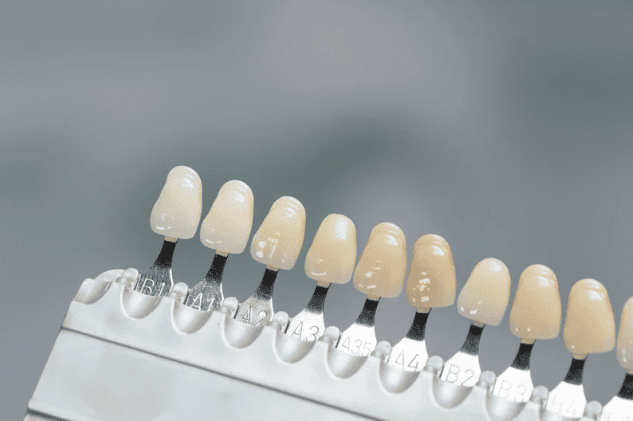
Dr. Sandeep Jain
Dental Implants, Bone Grafting, All on 4, Cosmetic Dentistry, Veneers, Dentures
Director / General Dentist
Speaks: English, Hindi, Punjabi
A veneer is a layer of material placed over a tooth it improves the aesthetics and function of a smile and protects the tooth’s surface from damage.
Dental veneers are often made from porcelain or resin-composite materials hand are permanently bonded to your teeth.

Dental veneers are thin shells used to cover teeth for cosmetic reasons. Veneers can be made using either porcelain or resin material; porcelain veneers mimic the natural teeth characteristics and resist stains better than resin materials. Veneers can be used to treat teeth that are discoloured, stained, worn down, chipped or broken, misaligned or irregularly-shaped and to fill gaps between teeth.
Veneer can be advised to conceal or correct cosmetic dental flaws like:
• Permanent discoloration on the teeth
• Teeth that differ in length or size
• Crooked and slightly misaligned teeth
• Chips, cracks or fractures in the teeth
• Gaps between teeth
• Severe tetracycline pigmentation
There are two different types of veneers:
1. The conventional Porcelain Veneers. These are up to 0.5-1 mm thick and require minimally invasive tooth substance removal for accommodation of these veneers.
2. The instant Dental Veneers, also called veneers-to-go or composite bonding, are an appealing and inexpensive alternative to conventional Porcelain Dental Veneers, but they have lesser aesthetic outcome and lesser longevity than porcelain veneers.
The choice of application for the two types of Veneers depends on patient’s aesthetic demands, procedural feasibility and various other criteria and must be individually decided by dentist in consultation with the patient.

Although, Porcelain veneers are the best option available in this segment, still it is essential to have expert advice. Depending on how visible the tooth damage is and what the extent of the flaw is, the dentist recommends different solutions. The more serious the tooth damage, the more imperative it is to provide customized tailor-made protection for the tooth from the laboratory. However, if the tooth damage is minor, Composite bonding can be a perfect and quick option, although it has less strength and longevity than porcelain veneers.
• The Dental Veneers are the best solution to get rid of unaesthetic stains on your teeth and to beautify the ugly appearance of ill-shaped teeth, as you get the perfectly contoured white teeth once the veneers are attached.
• The process is quicker relative to traditional treatments. Within a week or sometimes less than that you can wear a brand-new sparkling smile. You do not need to wait for months like in orthodontic (Braces) treatment for getting a dream smile. Or like in teeth whitening treatments of various kinds, which may require several sessions for the results to begin to appear.
• Instant makeovers. With latest technologies like CEREC, it is now possible to have veneers within hours on the same day. This technology not only delivers you the beautiful smile in a single dental visit but also eliminates any human error, being totally operated by computer programs and robotic mill-machines.
• The effect lasts for many years, in contrast to the teeth whitening procedures done by dentist in his clinic or done by you at home bleaching, where the whitened teeth can become stained again very soon.
• Dental Veneers add a layer of protection to the teeth. Veneers are an excellent treatment for teeth with enamel abrasion or enamel erosion.
• The harmonious white teeth give a wonderful psychological feeling and unparalleled self-confidence, as a beautiful smile is a key to the beauty of the mouth and face.
• Looks very similar to the natural teeth.
• Completely painless treatment.
• Unlike dental crowns, they require minimal and sometimes virtually zero enamel removal.
• Gentle on gums.

• Once your tooth is prepared for the Dental Veneer, the process is not reversible.
• Dental Veneers are not a good option for people with poor gum health.
The dentist will help you to decide how many Dental Veneers you need. A complete set can be applied to all visible front teeth if necessary and are made with different sizes and designed to match your existing tooth colour and your facial proportions, so that it looks completely natural. Normally 6 to 8 Veneers are recommended depending on your smile line and teeth visibility.
Number of Visits: 2 visits
Completion Time: 7 – 14 days
Recovery Period: None
Before veneer placement, you will consult your dentist to inform him about your aesthetic requirements and expectations. Your dentist will then discuss the best veneer material for your case, and the number of veneers that you require.
A number of factors will dictate this decision like the condition of your teeth, your budget, number of sittings required and availability of time. In certain situations, it may be essential to undergo other treatments before getting veneers, like minor gum surgery or using braces to correct uneven, crooked teeth.
The dentist will take X-rays to evaluate the health of your teeth and surrounding jawbone. This step is necessary to identify signs of any gum disease, tooth decay, or other tooth defects that may need to be addressed before getting veneers. Otherwise, you would not be a good candidate for veneers.
Explain to your dentist the results you are trying to achieve, during our diagnosis the dentist will examine the teeth to assess whether veneers would be appropriate. X-rays and impressions may be taken of your mouth.

Dental Implants, Bone Grafting, All on 4, Cosmetic Dentistry, Veneers, Dentures
Director / General Dentist
Speaks: English, Hindi, Punjabi

Dental Implants, Crowns, Veneers, Dentures, Invisalign, Kids Dentist, Teeth Whitening
General Dentist
Speaks: English, Cantonese, Mandarin

Cosmetic Dentistry, Smile Design, Veneers, Full Mouth Implants
General Dentist
Speaks: English

Family Dentist, Invisalign, Dental Crowns, Veneers, Teeth Whitening
General Dentist
Speaks: English, Cantonese, Mandarin, Swedish

Dental Crowns, Teeth Whitening, Dental Veneers, Invisalign
General Dentist
Speaks: English, Sinhala
Contact us to schedule your Dental Veneers consultation. Let us help you achieve the perfect smile with our professional services.